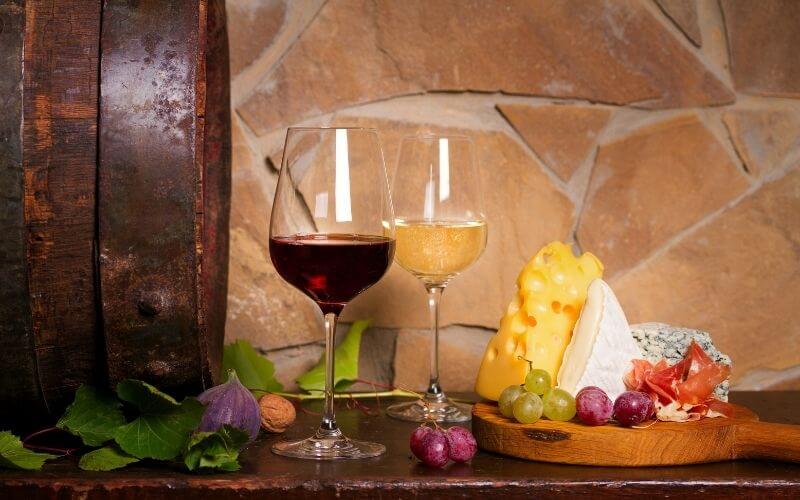
The Best Temperature For Wine To Get The Most Out Of Your Cheese


There's nothing quite like savoring a good glass of wine and some delicious cheese. But did you know that there is a proper temperature for every kind of wine? And what about the cheese?
It turns out that different cheeses pair well with different wines, and there are certain temperatures at which each one reaches its peak flavor.
In this blog post, we'll explore the best temperature for every kind of wine to get the most out of your wine and cheese experience!
Wines and cheeses require certain storage and serving temperatures. Wines have distinct flavor profiles and aromas that can only be completely appreciated when served at the correct temperature. When wine is served excessively cold, it dulls taste bud sensations, making it difficult to identify nuances.
Like those of wine, the rich tastes of old cheeses are best appreciated when consumed at the right temperature. When you've spent time and money picking cheeses, you'll want to treat them with the same respect when it comes to preserving and presenting them.
|
Type of Wine |
Recommended Wine Temperatures |
|
Sparkling |
38 - 45°F |
|
Light-Bodied (White) |
38 - 45°F |
|
Full-Bodied (White) |
45 - 55°F |
|
Aromatic White |
45 - 55°F |
|
Rosé |
45 - 55°F |
|
Dessert |
45 - 55°F |
|
Fortified |
57 - 65°F |
|
Light-Bodied (Red) |
55 - 60°F |
|
Medium-Bodied (Red) |
55 - 60°F |
|
Full-Bodied (Red) |
60 - 68°F |

Sparkling wines should be served chilled. The reason behind this is that “ice cold” temperatures assist in maintaining the carbon dioxide in sparkling wine, retaining the bubbles without making it frothy.
On the contrary, the fizziness of sparkling wine will disappear if it is kept at high temperatures, affecting both the taste and texture of the wine.
Remember to keep the open bottle on ice until you've finished it to have consistent carbonation and flavor throughout the drinking session.

The delicate fragrances, sharp tastes, and acidity of white wine and rosé are enhanced by keeping them refrigerated. It enhances their textured richness. Place these wines in the wine refrigerator for several hours or in the freezer for around 30 minutes before drinking.
Once opened, let the bottle sweat on the table rather than putting it on ice or back in the fridge since the wine's scents and character alter somewhat as the temperature increases.

The acidity in sweet wine should be balanced by the sweetness; hence it should be served cool. Otherwise, the wine will be sickeningly sweet. The serving temperature for dessert wines depends on the style, but it usually ranges from 45 to 55°F.
The ideal temperature is supposed to be 55°F. Although, avoiding severe changes or temperature swings is more crucial than attaining this ideal temperature of 55°F. Temperature fluctuations that are extreme or frequent are undesirable for dessert wines.
Restoring dessert wine once it has been refrigerated at this stage is not a wise practice. You should maintain constancy in the wine's storage temperature. Keep the open bottle of wine on ice until you've finished it.

The high amount of alcohol and sweetness present in fortified wines is their common trait. The temperature at which these wines should be served should be chosen by how they are most desired to be experienced.
If you want to emphasize the wine’s sweetness and the fragrance’s richness, serve the wine between 57 to 65°F. However, keep in mind that this will amplify the alcohol as well.
If you want to emphasize their freshness, or if you want to minimize the sweetness of delightful wine, serve them at a lower temperature of 50 to 57°F.

Red wine is often served at a higher temperature than white wine. It is not ideal for drinking chilled red wine as it becomes too acidic.
While following the widely held belief that red wine should be served at room temperature is also undesirable because it might make the wine appear watery and inconsistent. “Room temperature” is also conflicting depending on the location you are.
Additionally, if a wine has a high alcohol level, pouring it excessively warm will cause a burning sensation in the mouth, comparable to that of a shot of spirit. Store your red wine in the fridge for 15 to 30 minutes before serving it to your guests.
Make sure to let the wine breathe first by decanting or aerating it for about 10 minutes before finally consuming it.
Young red wines with little tannins and medium-bodied tannic red wines should be served at 55 to 60°F. Red wines with full body and loads of tannins that have been stored in bottles for years may be served at 60°F or, in extreme cases, at 68°F.
Higher humidity may cause labels to peel off bottles, while lower humidity can cause corks to dry up. The humidity level in your wine cellar or storage area should be around 60-68%.
Wax paper should be wrapped around the cork before inserting it back into the mouth of the bottle. The wax helps the cork fit into the mouth and prevents any stray pieces from falling into the bottle.

Exquisite hand-produced cheeses are the result of time-consuming procedures. After you've found the right cheeses for your occasion, you'll want to guarantee that you and your guests can consume and enjoy it with wine as well as possible by properly storing and serving them.
Serving cheese at room temperature is an optimal way of savoring it. If you want to appreciate it alone or with meat and fruits, it is best to keep it at 68 to 73°F. The milk fat softens in this temperature range, resulting in a more pleasing texture.
Cheese's milk fat turns hard and waxy at lower temperatures, and its distinct tastes and smells are muted when served chilled straight from the fridge. You won’t be able to appreciate its smooth, silky, and rich texture at cold temperatures. However, serving cheese at a higher temperature (around 80°F or higher) might cause the cheese to sweat and melt.
Remove your cheese from the fridge and put it on a plate an hour before you want to serve it to ensure that it is at room temperature. If you are a little extra and fancy, you may check the interior temperature of each cheese with a food thermometer.
When cheese is kept at too low a temperature, the active bacteria in the cheese become inactive.
If you are a wine connoisseur, there are two fridges you would want to consider: single-zone and dual-zone refrigerators. A single-zone fridge is perfect if you want to save space and you only have a small collection of wines.
On the other hand, a dual-zone refrigerator occupies more room than single-zone fridges. But they have the advantage of allowing you to apply different temperatures in each zone for different types of wine.
For single-zone refrigerators, it is best to set them to 54°F. While for dual-zone ones, they allow you to effortlessly and conveniently regulate the temperature of several wines in your wine cooler. For red wine, control the temperature between 50°F and 65°F, and for white wine, set the temperature between 45°F and 50°F.
Cheeses with low water or moisture content are safe to be left unrefrigerated. Hard cheeses like cheddar, gouda, Parmigiano Reggiano, pecorino romano, asiago d’allevo, and appenzeller are okay not to store in the fridge because they generate acidity while aging. This also prevents growing bacteria and other unwanted microorganisms in the cheese.
You can, but you should not. Cheese is made up of proteins, carbs, and fat molecules, but fats give it its flavor. When cheese cools, the fat molecules compress, trapping all of the flavors. When it's cold, the fat can't simply spread over your taste buds, and it's too late.
When cheese is warmer, the fat molecules relax, allowing the flavor to emerge. This is why the mere notion of warm, oozing cheese makes you salivate.
As you can see, there is a lot to consider when pairing wine and cheese. But by following the tips mentioned, you're sure to have a delicious and enjoyable experience!
Wine and cheese are two unarguably delightful food pairings that are enhanced when served at the appropriate temperature. Understanding how to serve these foods will maximize and improve your whole drinking and dining experience. However, feel free to experiment with the temperatures to see what you like most because—after all, the taste is subjective.
Have you tried pairing them before? Share your experience with us!


